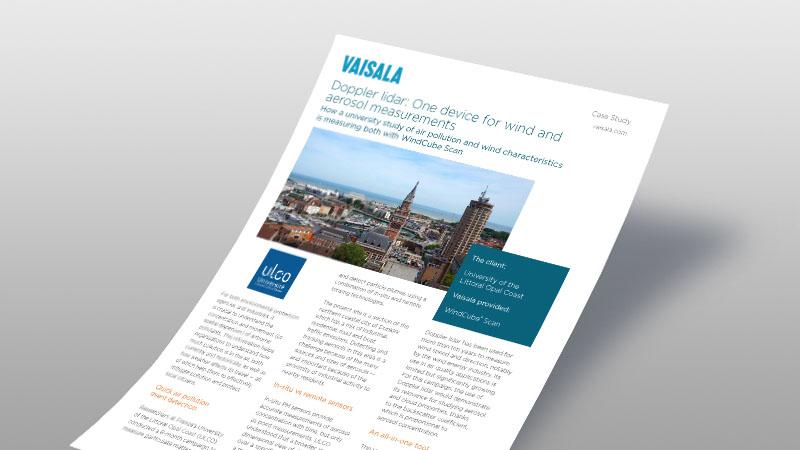Doppler lidar: One device for wind and aerosol measurements
How a university study of air pollution and wind characteristics is measuring both with WindCube Scan

The client: University of the Littoral Opal Coast
Vaisala provided: WindCube® Scan
For both environmental protection agencies and industries, it is crucial to understand the concentration and movement (or spatial dispersion) of airborne pollutants. This information helps organizations to understand how much pollution is in the air, both currently and historically, as well as how weather affects its travel — all of which help them to effectively mitigate pollution and protect local citizens.
Quick air pollution event detection
Researchers at France’s University of the Littoral Opal Coast (ULCO) conducted a 3-month campaign to measure particulate matter (PM) and detect particle plumes using a combination of in-situ and remote sensing technologies. The project site is a section of the northern coastal city of Dunkirk which has a mix of industrial, residential, road and boat traffic emissions. Detecting and tracking aerosols in this area is a challenge because of the many sources and sizes of aerosols — and important because of the proximity of industrial activity to nearby residents.
In-situ vs remote sensors
In-situ PM sensors provide accurate measurements of aerosol concentration with time, but only as point measurements. ULCO understood that a broader, multi- dimensional view of dispersion over a specific area would provide a much deeper understanding of aerosol movement and concentration.
Doppler lidar has been used for more than ten years to measure wind speed and direction, notably by the wind energy industry. Its use in air quality applications is limited but significantly growing. For this campaign, the use of Doppler lidar would demonstrate its relevance for studying aerosol and cloud properties, thanks to the backscatter coefficient, which is proportional to aerosol concentration.
An all-in-one tool
The University chose Vaisala WindCube Scan for their measurement project — both for its capabilities and their experience with its reliability and accuracy. WindCube Scan is the ideal multi- use tool, providing outstanding flexibility and useful at-a-glance insights. It provides simultaneous wind, boundary layer, cloud, and aerosol backscatter measurements, giving ULCO all the right data for this air quality research project.
ULCO set up the WindCube Scan in the harbor area of Dunkirk where it would be close to a coal power plant, petrochemical and agrochemical facilities, docks with ore and rubble storage, and the coast. To measure aerosols, the University set up a PPI horizontal scanning scenario at a low 2° elevation angle to provide a map of aerosol backscatter measurements, comparing them with a PM analyzer and optical particle counter.
Supporting ongoing air quality experiments
ULCO achieved their goal of combining aerosol quantification with wind information by using WindCube Scan as a multipurpose measurement device.
WindCube Scan Doppler lidar has a major advantage over PM sensors: It measures both wind and aerosol simultaneously, and can be used for 4D monitoring of their concentration. This data creates a full, essential picture of fugitive particulate emissions and wind conditions, significantly improving awareness and decision-making for air quality agencies and industries.
This demonstration is a strong step in the direction of the project’s larger goal: To demonstrate an unprecedented ability to quickly report excessive particulate emissions from an industrial site, support early warnings, and aid decision-makers by acting as a tool for locating and characterizing an air pollution incident. All of these will help protect the public and provide vital insights into mitigating air pollution.


